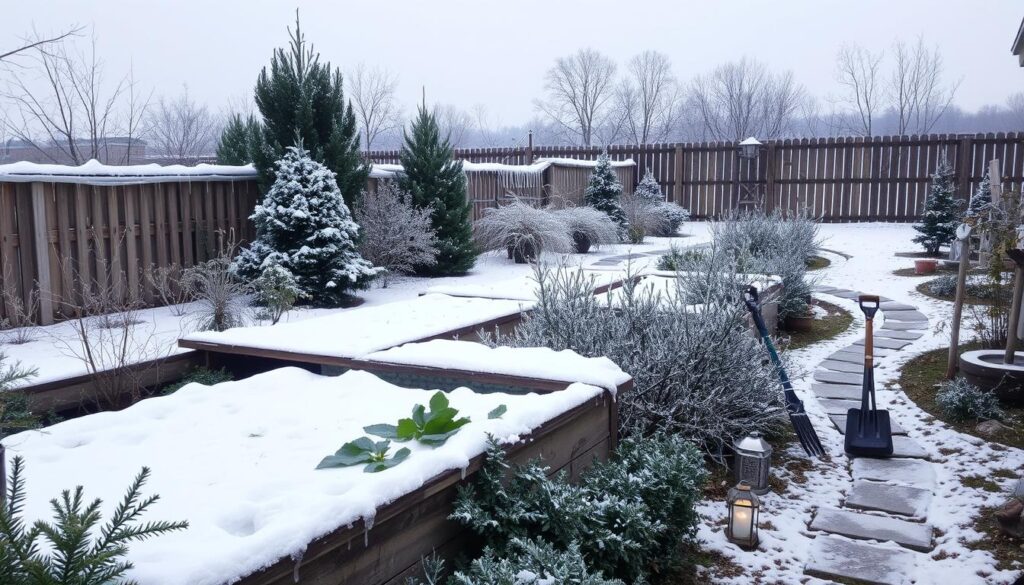As winter approaches, it’s time to prepare your garden. This guide offers expert advice on winter garden planning. It covers protecting plants, preparing soil, and more to ensure a healthy garden in spring.
Learn about plant dormancy and soil care in winter. Discover how to prune and maintain soil during cold weather. This guide helps both experienced and new gardeners keep their gardens thriving, even in harsh winter conditions.
Key Takeaways
- Gain a deeper understanding of plant dormancy and soil biology during the winter months
- Discover the essential tools and materials required for successful winter garden preparation
- Learn effective strategies for protecting perennial plants and shrubs from the elements
- Explore techniques for maintaining soil health and nutrient balance throughout the cold season
- Uncover guidelines for proper winter pruning and plant care to promote spring growth
Understanding Garden Dormancy in Winter Months
As winter comes, it’s key to know about plant dormancy and its impact on your garden. Plants rest during the winter, called plant dormancy, to save energy and protect themselves from cold.
Plant Life Cycles During Cold Seasons
In the cold season gardening, plants follow a cycle of growth, rest, and renewal. As it gets colder, plants stop growing and save energy. This winter plant biology helps them make it through winter and get ready for spring.
Soil Biology in Winter Conditions
Just like plants, the soil health in your garden changes in winter. The soil biology slows down, with fewer tiny life forms and less nutrient movement. Knowing these changes helps keep your garden healthy during the cold months.
Temperature Effects on Garden Elements
Winter’s temperature changes affect your garden a lot. Freezing and thawing can harm plant roots, garden structures, and soil. It’s important to watch for these effects and take steps to protect your garden from winter’s challenges.
| Garden Element | Impact of Winter Temperatures |
|---|---|
| Plant Roots | Freezing and thawing can cause root damage and increased susceptibility to disease |
| Garden Structures | Extreme cold can lead to cracking, warping, or even collapse of structures like greenhouses or sheds |
| Soil Composition | Repeated freezing and thawing can alter soil texture, nutrient levels, and water-holding capacity |
“Understanding the rhythms of plant dormancy and soil biology is the key to successful cold season gardening.”
Essential Tools and Materials for Winter Garden Prep
As winter approaches, getting your garden ready is key. You’ll need the right winter gardening tools, cold weather supplies, and garden winterization equipment. This ensures your garden stays healthy and vibrant during the cold season.
Let’s explore the essential items for winter garden prep:
- Insulating fabrics and covers to shield delicate plants from frost and harsh winds
- Soil temperature probes to monitor the ground conditions
- Mulch or compost to enrich and insulate the soil
- Pruning shears and saws for trimming back dormant plants
- Heated bird baths or deicer devices to provide a water source for wildlife
- Soil test kits to assess nutrient levels and pH balance
- Garden hoses and sprinklers for controlled watering during dry spells
Choosing the right winter gardening tools and cold weather supplies is crucial. It helps keep your garden healthy through winter and prepares it for a strong spring. With the right garden winterization equipment, you’ll face winter gardening tasks with confidence.
| Essential Winter Garden Tools | Purpose |
|---|---|
| Frost Blankets and Row Covers | Protect plants from frost, wind, and cold temperatures |
| Soil Thermometer | Monitor soil temperature for optimal growing conditions |
| Pruning Shears and Saws | Trim back dead or damaged plant growth |
| Mulch or Compost | Insulate and enrich the soil for winter protection |
| Garden Hoses and Sprinklers | Provide controlled watering during dry winter spells |
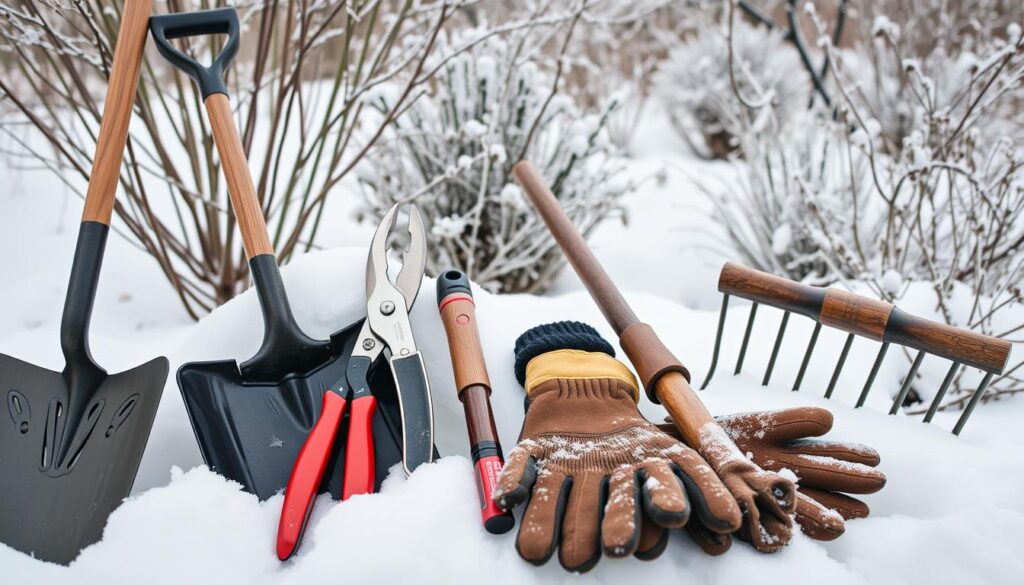
Choosing the right winter gardening tools, cold weather supplies, and garden winterization equipment is crucial. It helps your garden thrive and withstand winter’s challenges.
Winter Planning for the Garden: Creating Your Strategy
Winter is the best time to plan your garden. A good plan will make your garden healthy and productive during the cold months. By mapping your garden layout, setting timeline goals, and managing resources effectively, you can have a great garden in the spring.
Mapping Your Garden Layout
Start by mapping out your garden. Think about what each area needs. This helps you place plants, structures, and paths well. Remember to consider sun, soil, and microclimates for your garden planning.
Setting Timeline Goals
Make a clear gardening timeline for winter and spring. This keeps you on schedule and makes the most of growing seasons. Think about starting seeds, transplanting, and crop rotation for a smart winter strategy.
Resource Management Tips
- Check your tools, materials, and supplies for what you need.
- Keep your gardening equipment organized and ready for spring.
- Use your budget wisely for the most important layout design and investments.
Planning your winter garden strategically will lead to a thriving outdoor space. Tailor your plan to your needs and climate for a smooth transition to spring.
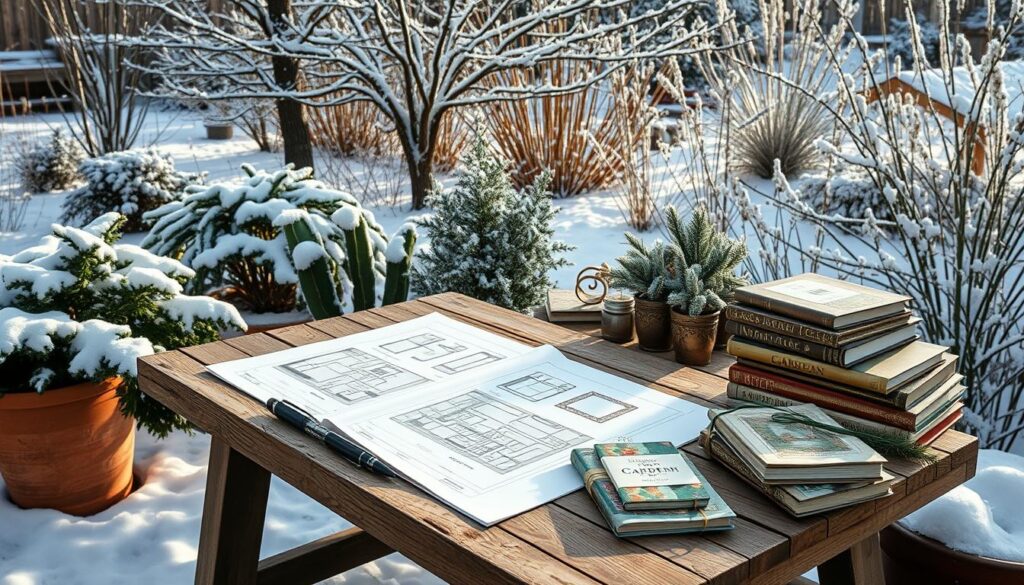
Protecting Perennial Plants and Shrubs
As winter gets closer, it’s key to protect your perennial plants and shrubs. Keeping them healthy is vital for a great garden next year.
Mulch is a great way to protect perennials. Use organic mulch like wood chips or straw around your plants. It keeps the soil warm and moist, protecting against frost.
Wrapping shrubs and young trees with burlap or plant wrap is also smart. It shields them from wind and frost. For more protection, mound soil or compost around the plants.
| Perennial Protection Technique | Benefits |
|---|---|
| Mulching | Insulates soil, prevents freeze-thaw, retains moisture |
| Wrapping with Burlap or Plant Wrap | Creates a physical barrier against wind, frost, and cold |
| Mounding Soil or Compost | Provides additional insulation and protection around the base of plants |
Using these perennial protection methods helps your plants make it through winter. They’ll be ready to grow beautifully in the spring.
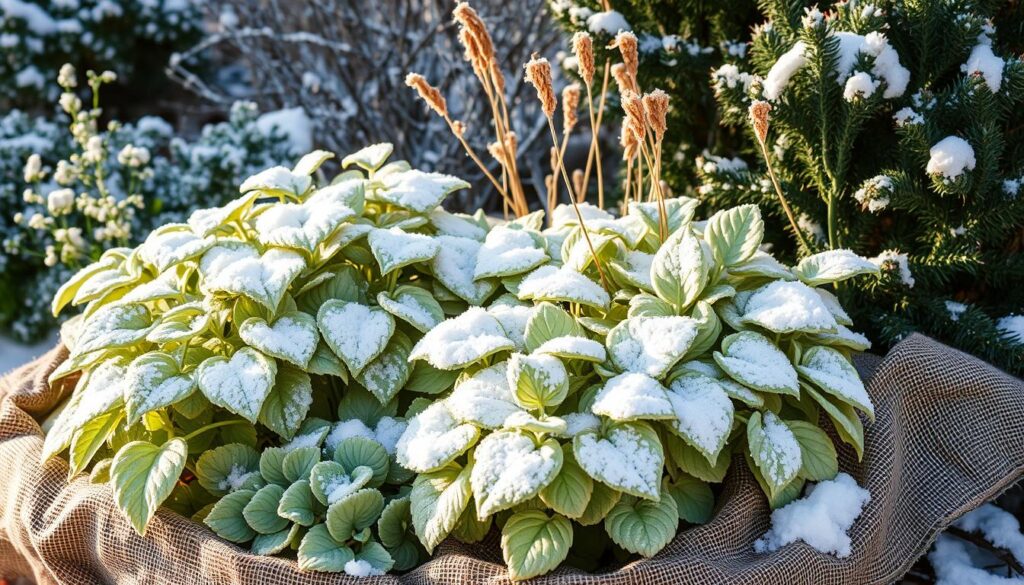
Soil Preparation and Maintenance Techniques
As winter comes, it’s key to get your garden’s soil ready. Good soil care now means a better garden in spring. We’ll look at how to prepare and keep your soil, including mulching, pH balance, and composting in cold weather.
Mulching Methods for Winter Protection
Putting mulch around plants is a smart move to keep soil warm. Mulching techniques like shredded leaves or straw keep moisture in and weeds out. They also add nutrients to the soil as they break down.
pH Balance Maintenance
Keeping the right soil pH is vital for plant health. It’s especially important in winter. Test your soil’s pH and adjust it if needed to help your plants grow well.
Composting During Cold Months
Winter composting needs some tweaks, but it’s worth it. Choose a method that works in cold weather, like an insulated bin. Make sure the compost stays moist to keep it working.
Using these winter soil care tips will help your garden bloom in spring. Healthy soil is the key to a great garden. So, take care of your soil during the cold months.
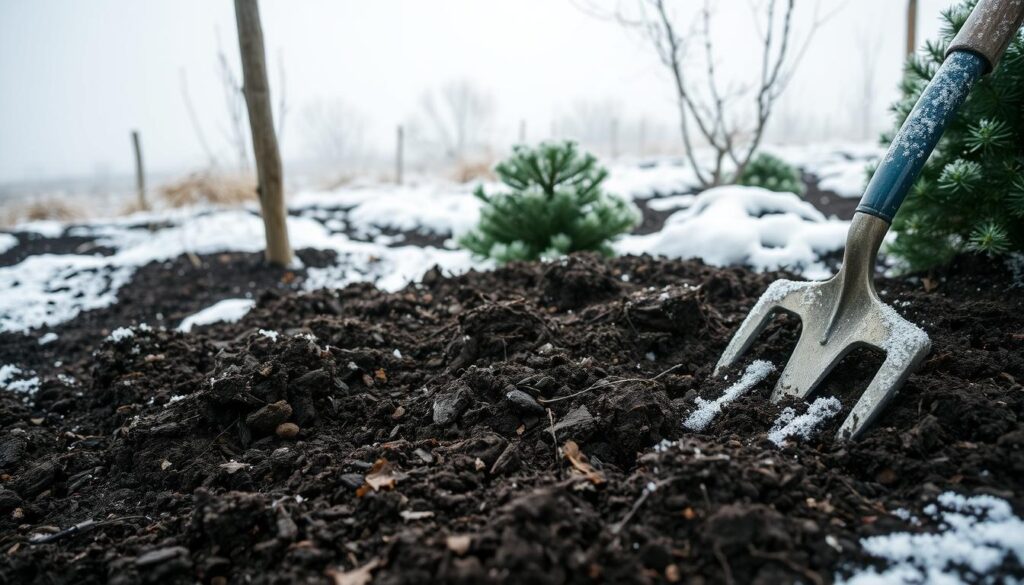
Winter Pruning and Plant Care Guidelines
As winter arrives, it’s important to take care of your garden. Proper pruning and care during the dormant season help plants grow strong and look great next year. Knowing what plants need during this time is key to a healthy garden.
Mastering Winter Pruning Techniques
Pruning in the winter keeps trees, shrubs, and perennials in shape. It’s the best time to cut out dead or damaged parts. This lets plants focus on growing new, healthy parts in the spring.
- Identify the right time to prune based on the plant’s life cycle and dormancy period.
- Use sharp, clean pruners to make precise cuts, avoiding ragged edges that can invite pests and disease.
- Focus on removing crossing or rubbing branches, as well as any suckers or watersprouts.
- Be mindful of the plant’s natural growth habit and prune accordingly to maintain its desired shape.
Caring for Plants During the Dormant Season
There’s more to caring for plants in winter than just pruning. Here are some important steps:
- Mulching around the base of plants to insulate roots and retain moisture.
- Regularly inspecting for signs of pests or disease and taking appropriate action.
- Providing extra protection for tender or marginally hardy plants, such as covering or wrapping.
- Maintaining proper soil moisture levels throughout the dormant period.
By following these winter pruning and care tips, you can make your garden vibrant and healthy for the future.
“Proper winter pruning is the key to unlocking a garden’s full potential in the spring.”
Managing Garden Structures and Infrastructure
As winter gets closer, it’s vital to protect your garden’s structures and infrastructure. This includes winterizing irrigation systems and keeping outdoor features safe. Good preparation is essential to help your garden survive the cold months.
Winterizing Irrigation Systems
One key task is to keep your irrigation system in good shape. Start by turning off the water supply and draining all water from pipes and sprinklers. This stops freezing and damage. Also, insulate any exposed pipes and faucets to keep them safe from the cold.
Protecting Garden Features
Outdoor structures like sheds and trellises need extra care in winter. Check them for any loose or broken parts and fix them before the first frost. You can also cover or wrap them to protect from snow, ice, and wind.
Equipment Storage Solutions
- Keep gardening tools and equipment in a dry, safe place like a shed or garage. This keeps them safe from winter weather and prevents rust or damage.
- Do maintenance on motorized tools like lawnmowers and tillers. Also, drain fuel tanks to avoid problems when they’re not in use.
- Store fragile items like clay pots and outdoor furniture in a place with a steady temperature. This prevents them from cracking or getting damaged.
By winterizing your garden’s structures and infrastructure, you can keep your outdoor space safe and ready for spring. From taking care of irrigation systems to protecting outdoor features and storing equipment, a thorough winter plan will help your garden thrive in the future.
Indoor Gardening Options During Winter
When the outdoor garden is quiet in winter, you can still grow plants indoors. This lets you keep your green thumb busy while it’s cold outside. You can grow indoor plants, care for houseplants, and even use grow lights. Winter can be a fun time for those who love winter gardening.
Growing your own herbs indoors is very rewarding. Herbs like basil, rosemary, and thyme love the warm, bright spots inside. With a sunny spot or a grow light, you can have fresh herbs all year, even in winter.
Looking after your houseplants is another great indoor gardening task. Many indoor plants, like succulents and philodendrons, do well in winter’s lower light and cooler temps. With the right care, your houseplants can stay healthy and brighten up your home.
| Indoor Gardening Essentials | Benefits |
|---|---|
| Grow Lights | Provide the necessary light for plants to photosynthesize and grow during the winter months when natural sunlight is limited. |
| Well-Draining Potting Soil | Ensures the roots of your indoor plants have the proper drainage and aeration they need to stay healthy. |
| Watering Schedule | Helps you maintain the right moisture levels for your indoor plants, preventing over or under-watering. |
Indoor gardening lets you stay active with plants, even when it’s cold outside. You can grow herbs, care for houseplants, or try grow lights. Winter gardening is a fun and rewarding hobby.
Planning Spring Beds and Early Crops
Winter is ending, and it’s time to plan for spring. Smart gardeners know that careful winter planning is key. By mapping out your spring beds and picking the right early crops, you can make your garden thrive from the start.
Seed Selection Strategies
Choosing the right seeds is crucial for a great spring garden. Here are some tips for picking seeds:
- Look for seeds that resist disease and can handle cold weather.
- Choose open-pollinated or heirloom seeds for better genetic diversity.
- Check the maturity dates of different crops to plan your harvest.
Timing Your Spring Plantings
Timing is everything in spring gardening. Knowing the best planting times for your area and crops is important. Here are some tips:
- Start seeds indoors a few weeks before the last frost date.
- Plant seeds outside when the soil is at the right temperature for each crop.
- Plant different crops at different times for a steady harvest.
With good spring garden planning, smart seed selection, and careful planting schedules, your early crops will flourish.
Winter Pest and Disease Prevention
As winter comes, it’s vital to protect your garden from pests and diseases. Keeping your garden ecosystem healthy during the cold months is key. This way, your garden will thrive when spring arrives.
Inspect your plants for fungal growth or bacterial infections. Watch out for powdery mildew, root rot, and leaf blight. These can harm your plants in the cold. Remove any sick leaves or stems to stop these problems from spreading.
It’s also crucial to prevent pests. Aphids, spider mites, and scale insects can harm your plants in winter. Use natural pest control, like introducing beneficial insects or applying horticultural oils, to keep pests away.
- Regularly inspect plants for signs of disease or pest infestations
- Promptly remove and dispose of any affected plant material
- Encourage beneficial insects to help control pests naturally
- Apply organic, eco-friendly pest control products as needed
- Maintain good garden hygiene by cleaning up debris and fallen leaves
| Common Winter Pests | Potential Plant Diseases |
|---|---|
| Aphids | Powdery Mildew |
| Spider Mites | Root Rot |
| Scale Insects | Leaf Blight |
By being careful and using these winter plant diseases and garden pest control tips, your garden will stay healthy. It will be ready to bloom in the spring.
“A healthy garden is a thriving garden, even in the depths of winter.”
Conclusion
As we finish our guide to winter garden planning, it’s clear that getting ready and taking care of your garden is key. Knowing how plants rest, keeping soil healthy, and protecting your garden’s structure will help you achieve winter garden success.
We’ve looked at the important steps for seasonal planning and garden preparation. This includes planning your garden’s layout and using effective pruning and pest control. By being proactive and following these tips, you’ll make sure your garden grows well, even when the weather is unpredictable.
The effort you put in during the cooler months will show when your garden comes alive in the spring. Enjoy the process, stay organized, and watch your garden flourish all year. Here’s to a successful and rewarding gardening year ahead!
FAQ
What is the purpose of this expert winter planning for the garden guide?
This guide offers expert advice on winter garden planning. It covers protecting plants, preparing soil, and more. You’ll learn about dormancy, tools, and planning for a successful winter garden.
How can understanding garden dormancy help with winter gardening?
Knowing about garden dormancy is key. It helps you plan and maintain your garden during winter. You’ll learn about plant life cycles, soil changes, and how temperature affects your garden.
What essential tools and materials are needed for winter garden preparation?
This guide lists must-have tools and materials for winter gardening. You’ll find frost protection, soil amendments, and equipment for cold-weather tasks. This ensures you’re ready for the season.
How can I develop a successful winter garden planning strategy?
The guide offers tips for a good winter garden plan. You’ll learn to map your garden, set goals, and manage resources. This helps tailor your plan to your needs and climate.
What techniques can I use to protect perennial plants and shrubs during winter?
Learn to protect perennials with mulching, wrapping, and proper watering. This helps them survive the cold and thrive next season.
How can I prepare and maintain the soil during the winter months?
Discover how to prepare and maintain soil in winter. Learn about mulching, soil pH, and composting. This leads to healthier soil and better plant growth in spring.
What are the best practices for winter pruning and plant care?
Get insights into winter pruning and plant care. Learn to trim trees, shrubs, and perennials during dormancy. This promotes healthy growth and shape in the next season.
How can I manage my garden structures and infrastructure during the winter?
Learn to manage and protect garden structures in winter. You’ll find tips on winterizing irrigation, safeguarding features, and storing equipment. This prevents damage from harsh weather.
What indoor gardening options are available during the winter months?
Explore indoor gardening options for winter. Learn to grow herbs, care for houseplants, and use grow lights. This keeps your gardening passion alive indoors.
How can I plan for spring beds and early crops during the winter?
Prepare for spring by planning beds and early crops in winter. Learn about seed selection and timing plantings for optimal growth and harvest.
What measures can I take to prevent pests and diseases in my winter garden?
Discover ways to prevent pests and diseases in winter. Learn to protect plants from common threats and maintain a healthy garden ecosystem.
Share this post: on Twitter on Facebook

